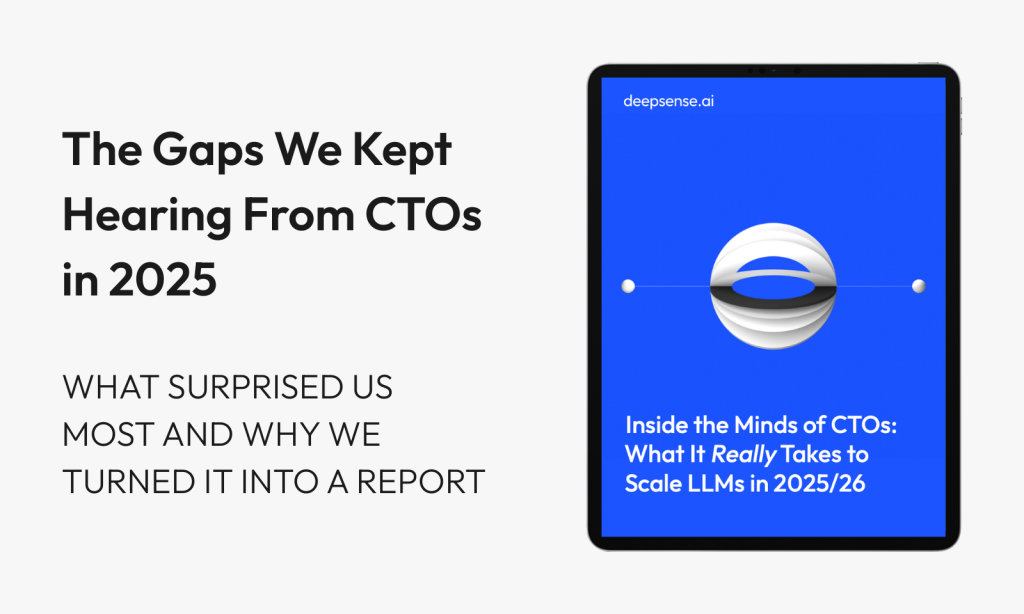
Table of contents
The future of AI is agentic, but for many AI-first companies, the dream of a compelling proof-of-concept quickly turns into a nightmare in production. Why do so many generative AI (GenAI) proofs-of-concept (PoCs) fail to make it to production? Often, it’s due to a lack of robust observability, comprehensive evaluation, and proper lifecycle management.
Have you ever found your agent hallucinating without a clue why? Or seen a perfect demo fall apart in production? Perhaps your legal department won’t approve your agent’s deployment due to compliance concerns? This is precisely where AgentOps comes into play, serving as the crucial bridge to reliably scale generative AI (GenAI) products, addressing these common pitfalls head-on.
TL;DR – What You’ll Learn:
- Why GenAI PoCs fail
It’s not the models, it’s the missing ops layer. Many PoCs collapse when transitioning to production because they lack proper observability, evaluation frameworks, and compliance controls. If you’ve ever seen an LLM-based agent excel in demo and then completely break in real-world use, this is why. - What is AgentOps
Think of AgentOps as the next evolution after MLOps – purpose-built for generative AI agents that reason, plan, and act autonomously. It’s the operational backbone for AI products that need to scale reliably and meet enterprise standards. Core components of AgentOps:- Prompt Engineering & Orchestration: Structured agent “brains” that steer decisions, not just LLM prompts hacked together. Without orchestration, agents hallucinate, fail tasks, or behave unpredictably.
- Tool Management & External Integrations: Scalable frameworks to manage APIs, data sources, and tools — because production agents live in ecosystems, not sandboxes.
- Memory Systems: Agents need persistent, structured memory to retain session data, patterns, and prior knowledge — critical for multi-turn reasoning and user personalization.
- Evaluation & Observability: Automated performance evaluations, trajectory tracking, and detailed traces to debug the “why did it fail” — not just “what failed.” This is where most teams falter post-PoC.
- Security & Governance: Without airtight governance — RBAC, IAM, VPC controls — your legal and compliance teams will kill the deployment before it sees daylight.
- When to apply DevOps, MLOps, and AgentOps
We break down exactly when each operational practice applies, because deploying a deterministic app, a predictive ML model, or an autonomous agent demands very different toolsets and mindsets. - Why you must treat agents as evolving products
LLM agents are not static APIs, they’re evolving entities that require continuous feedback, retraining, and optimization. Treating them like code you can “set and forget” is a fast track to production failures. - Metrics that matter in AgentOps
It’s not just about latency and error rates. You’ll learn what to measure, from goal completion rates to reasoning path analysis, so you can proactively optimize before users hit failure points.
1. What is AgentOps, and Why Now?
Generative AI agents represent a significant advancement over traditional language models, offering a dynamic approach to problem-solving and interaction. An agent is an application designed to achieve specific objectives by perceiving its environment and acting strategically using available tools. The core principle of an agent involves synthesizing reasoning, logic, and access to external information to perform tasks and make decisions beyond the underlying model’s inherent capabilities. These agents can operate autonomously, pursuing goals and determining actions without explicit instructions.
1.1. Evolution from MLOps and DevOps
Over the past two years, the field of Generative AI (GenAI) has seen significant changes, with enterprises focusing on operationalizing these solutions. This has led to various terms like MLOps for GenAI, LLMOps, FMOps, and GenAIOps (see Figure 1).
Agent and Operations (AgentOps) is a subcategory of GenAIOps that focuses on the efficient operationalization of Agents. Its main additional components include internal and external tool management, agent brain prompt (goal, profile, instructions) and orchestration, memory, and task decomposition.
Starting from the beginning of the Operations-related terms, DevOps is the practice of efficiently productionizing deterministic software applications by integrating the elements of people, processes, and technology.
MLOps builds upon DevOps, focusing on the efficient productionization of ML models. The primary distinction is that the output of an ML model is non-deterministic and relies on the input data.
Foundation Model Operations (FMOps) expands upon the capabilities of MLOps and focuses on the efficient productionization of pre-trained or customized FMs. Prompt and Operations (PromptOps) is a subcategory of GenAIOps that focuses on operationalizing prompts effectively. RAG and Operations (RAGOps) is a subcategory of GenAIOps that centers on efficiently operationalizing RAG solutions.
Figure 1. Relationship between “Ops”, including AgentOps (source: Medium).
All of these “Ops” are, in essence, the harmonious blend of people, processes, and technologies working together to efficiently deploy machine learning solutions into a live production environment.
2. Core Components of AgentOps That Matter for Product
For product teams aiming to deploy reliable and effective AI agents, understanding the core components of AgentOps is crucial. These elements ensure that agents not only function as intended but can also be continuously monitored, evaluated, and improved in production environments.
- Prompt Engineering and Orchestration: At the heart of an agent’s “brain” are its prompts, goals, profiles, and instructions. The orchestration layer is a cyclical process that dictates how the agent assimilates information, engages in internal reasoning, and uses that reasoning to inform its next action or decision. This includes maintaining memory, state, reasoning, and planning. Techniques like ReAct, Chain-of-Thought (CoT), and Tree-of-Thoughts (ToT) are applied here to steer reasoning and planning.
Without careful prompt engineering and orchestration, agents can easily ‘hallucinate’ or deviate from intended behavior, leading to unpredictable and unreliable outputs, making debugging a nightmare.
- Tool Management and Integration: Agents rely heavily on tools to interact with the external world, bridging the gap between internal capabilities and external data/services. This involves managing extensions, functions, and data stores, which allow agents to access and process real-world information. A robust system is needed to discover, register, administer, select, and utilize from a “mesh” of tools or agents, including their ontology, capabilities, requirements, and performance metrics.
- Memory Management: Agents need effective memory to retain and utilize information. This includes short-term working memory for immediate context (cache, sessions) and long-term storage for learned patterns, experiences, examples, and reference data. “Reflection” mechanisms decide which short-term items should be copied into long-term memory, and whether this can be shared across agents, tasks, or sessions.
- Evaluation and Observability: Moving from a proof-of-concept to production often reveals that agents behave differently than expected. A robust and automated evaluation framework is essential not just for knowing what happened, but why. This goes beyond just the final output and requires understanding the agent’s decision-making process. Detailed traces are crucial for debugging those frustrating moments when ‘it worked in demo, but failed in production. Observability also involves tracking high-level business metrics (e.g., goal completion rate, user engagement) and granular application telemetry (e.g., latency, errors), with detailed traces to debug issues.
- Human-in-the-Loop Evaluation: While automated evaluations are efficient, human feedback is critical for subjective judgments, contextual understanding, and iterative improvement. This direct assessment, comparative evaluation, and user studies also help calibrate and refine automated evaluation approaches.
- Security and Governance: Especially for enterprise deployments, the question ‘will our legal department approve this agent?’ often comes up. Built-in trust, security, and governance are paramount to ensure compliance and gain internal approval. This includes features like single sign-on (SSO), integrated permissions models, user-level access controls, role-based access control (RBAC), VPC Service Controls, and IAM integration to ensure data protection and compliance.
These components form the backbone of a successful AgentOps strategy, enabling product teams to develop, deploy, and manage AI agents effectively and at scale.
3. Beyond MVPs – AgentOps for Scalable Production
The journey from a proof-of-concept to a production-ready AI agent is challenging, but AgentOps provides the necessary framework to ensure quality and reliability in deployment. For scalable production, product teams must shift their focus from simply building functional agents to operationalizing them with robust processes and continuous improvement in mind.
Metrics-driven Development
One crucial aspect is metrics-driven development. AgentOps emphasizes defining and tracking both high-level business metrics (e.g., goal completion rate, user engagement, sales totals) and granular application telemetry metrics (e.g., latency, errors). These metrics serve as the “north star” for agent performance and allow for continuous optimization, much like A/B experimentation in traditional software development. Detailed traces of the internal workings of the agent are also vital for debugging when issues arise in production.
For agents to truly scale in production, the concept of ‘contracts’ is being proposed to evolve the agent interface. This addresses the underspecified definitions that often hinder agents from moving from prototype to production, especially in high-stakes contexts, thereby enabling scalable and predictable behavior.
Agent & Tool Registry
The ability for agents to leverage a robust Agent & Tool Registry becomes increasingly important as the number of agents or tools grows. This registry helps manage capabilities, ontology, performance metrics, and enables agents to intelligently choose the right tools or other agents based on defined criteria.
Security & Governance
Finally, security and governance are paramount in enterprise-level production environments. Platforms designed for AgentOps, like Google Agentspace, offer built-in security features such as SSO, integrated permissions, user-level access controls, RBAC, VPC Service Controls, and IAM integration. These ensure that sensitive company data is protected and regulatory compliance is maintained throughout the agent’s lifecycle in production.
4. AgentOps vs DevOps vs MLOps – When Do You Need What?
Understanding the distinctions and overlaps between AgentOps, DevOps, and MLOps is crucial for effective AI product development. While they share common principles, each has unique focuses.
4.1. Decision tree: When to use each
- DevOps: This is the foundational layer for any software development. You need DevOps practices (version control, CI/CD, testing, logging, security) when developing and deploying any deterministic software application. If your product is a traditional application with predictable outputs, DevOps is your primary operational framework.
- MLOps: You need MLOps when you are dealing with machine learning models. This builds upon DevOps by adding capabilities specific to the lifecycle of ML models, such as data versioning, model training, model versioning, model monitoring, and continuous retraining. The key differentiator is the non-deterministic output of ML models and their reliance on input data.
- AgentOps: You need AgentOps when you are working with AI agents, particularly generative AI agents that exhibit autonomous behavior and utilize tools. AgentOps is a subcategory of GenAIOps. It inherits practices from both DevOps and MLOps but adds specific considerations for agent brain prompt orchestration, internal and external tool management, memory, and task decomposition.
4.2. Shared practices (logging, deployment, security)
All three “Ops” paradigms share fundamental practices that are essential for efficient and reliable operations:
- Version Control: Managing code, configurations, data, and models across development stages.
- Automated Deployments (CI/CD): Streamlining the process of integrating changes and delivering them to production environments.
- Testing: Ensuring the quality and correctness of the software, models, or agents.
- Logging: Capturing events and data for monitoring, debugging, and auditing purposes.
- Security: Implementing measures to protect systems and data from unauthorized access, breaches, and other threats. This includes authentication, secret management, privacy, and compliance.
- Metrics and Observability: Measuring system performance, outcomes, and business metrics to drive continuous improvement and provide insights into system behavior.
4.3. What’s unique about GenAI agents
While sharing common ground, GenAI agents introduce unique operational challenges and requirements that necessitate AgentOps:
- Non-deterministic and Autonomous Behavior: Unlike traditional software or even many ML models, agents can make decisions and take actions autonomously, often without explicit instructions. This makes their behavior less predictable and harder to control, requiring advanced evaluation and monitoring.
- Tool Use and External Interactions: Agents interact extensively with external tools, APIs, and data sources. Operationalizing agents involves managing this dynamic interaction, including authentication, rate limiting, and error handling for external tools.
- Orchestration and Reasoning Complexity: The internal reasoning and planning capabilities of agents (e.g., ReAct, CoT, ToT) add layers of complexity to their execution flow. AgentOps focuses on orchestrating these complex reasoning trajectories.
- Memory Management: Agents often require sophisticated memory systems (short-term, long-term, and reflection) to maintain context and learn over time, which needs careful operationalization.
- Evaluation of Trajectory and Final Response: Evaluating agents goes beyond just the final output; it includes analyzing the sequence of actions (trajectory) an agent takes and the quality of the final response, often with LLMs acting as “autoraters”.
- Multi-Agent Coordination: For systems with multiple collaborating agents, AgentOps addresses how well agents cooperate, coordinate, plan, assign tasks, and utilize each other.
In essence, AgentOps provides the specialized toolkit needed to manage the unique lifecycle of AI agents, ensuring they can be developed, deployed, and maintained reliably in production, leveraging the best practices of MLOps and DevOps while addressing the specific challenges of agentic AI.
5. Key Takeaways for Product Teams
For product teams embarking on the journey of building and deploying AI agents, a few critical takeaways from the AgentOps paradigm stand out:
- Build once, deploy responsibly: While it’s easy to get an AI agent proof-of-concept off the ground, ensuring high-quality results in production requires a responsible deployment strategy. This means embracing AgentOps principles from the outset, integrating best practices from DevOps and MLOps, and specifically focusing on agent-centric elements like robust tool management, intelligent orchestration, and comprehensive memory systems. The goal is not just to build a functional agent, but to build one that can be reliably scaled and maintained in live environments.
- Invest in traceability and metrics early: Don’t wait until production to think about how your agents are performing. Start with defining clear business-level Key Performance Indicators (KPIs) that align with your product’s goals, such as goal completion rates, user engagement, or even revenue. Beyond these high-level metrics, instrument your agents to capture granular telemetry, including detailed traces of internal agent actions and interactions. This detailed observability is invaluable for debugging and understanding why an agent behaves a certain way, especially given their non-deterministic nature. Furthermore, actively solicit human feedback through user surveys or direct assessments, as this provides crucial qualitative insights that automated metrics might miss.
- Treat agents as evolving products, not fixed tools: Unlike traditional software, AI agents are inherently dynamic and adaptive. They are not static tools but rather evolving products that require continuous iteration and refinement. This means implementing automated evaluation frameworks that assess not only the final response but also the agent’s decision-making process and trajectory. Leverage techniques like exact match and precision/recall for trajectory evaluation, and utilize LLM-as-a-judge autoraters for final response quality. The continuous feedback loop from both automated evaluations and human-in-the-loop processes is essential for calibrating and improving your agents over time, ensuring they remain relevant and performant as your product evolves and user needs change.
- By enabling reliable scaling and reducing debugging time and production failures, AgentOps ultimately contributes to the cost-effectiveness of deploying and managing AI agents in the long run.
6. In Summary
The path from GenAI PoC to production is littered with failures, not because the technology isn’t ready, but because the operational discipline around it is often missing. That’s where AgentOps steps in: bridging the gap between a flashy demo and a reliable, scalable product.
If you’re navigating the challenges of operationalizing AI — whether in DevOps, MLOps, AIOps, or AgentOps — and finding the road bumpier than expected, we can help.
Drop us a message — let’s make sure your AI doesn’t just impress in a demo but thrives in production.
Table of contents






